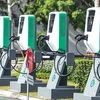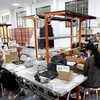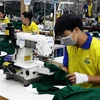Hanoi (VNA) - The Ministry of Finance is drafting regulations on e-bills and will ask the Government to set a deadline of July 2018 for businesses to switch over from paper. But local businesses say they don’t have the information technology resources to meet the proposed deadline.
Their concerns were heard at an online discussion on e-invoices held on Tuesday. The Government is seeking to promote e-invoices because statistics from the General Department of Taxation showed that while paper invoices cost a total of 4 trillion VND (177.8 million USD) a year, universal e-invoice use would cost only 1 trillion VND. E-invoices also make it more difficult for businesses to evade taxes while ensuring they receive all the tax refunds to which they are entitled.
“The application of e-invoices could create transparency for all transactions. When the use of e-invoice becomes popular, transactions of even less than 200,000 VND will result in a tax refund. This could bring big profits to companies,” said Dau Anh Tuan, head of the Vietnam Chamber of Commerce and Industry’s Legal Department.
The number of businesses using e-invoices has increased steadily. By the end of June, there were some 2,700 firms using 300 million e-invoices, up from 800 firms at the end of last year. Nearly 2,400 businesses used e-invoices verified by tax agencies in the pilot implementation of the General Department of Taxation in 2014.
However, Tuan expressed doubts about the implementation timeline proposed, as the department has received many complaints from firms about the short amount of time they would have to replace paper bills.
He said many small and micro companies are particularly worried about meeting the implementation deadline.
Firms have also wondered about the invoice form and agencies issuing the invoices.
Nguyen Dai Tri, deputy director of the General Department of Taxation (GDT), said the e-invoices could be completed in three forms, similar to the current situation with paper invoice. Firms could issue their own invoices, use intermediaries or verified invoices from tax departments.
Big groups such as VNPT and EVN could build their own e-invoices while small-and-medium sized firms could use services from intermediate agencies such as BKAV and Viettel.
E-invoices would bring conveniences for both tax agencies and tax payers. They could help businesses save time and money, and better manage their invoices. Tax agencies would have a database for inspections and discovering fraud activities in issuing invoices.
“However, any change or reform could have affects to the society and firms. It was the reason that the Government should have a careful roadmap. Businesses using paper invoices could gradually shift into e-invoices,” he said, adding that management agencies would try not to harm production and businesses.
He said that the tax industry would continue to use paper invoices in parallel with e-invoices. With the strong development of IT, most businesses have been ready for online transactions. The use of e-invoices therefore would not be too difficult for firms.
Tri added that the GDT proposed to MoF that the deadline for the shift from paper invoices to e-invoices be done even in July 2019.
He said the GDT has implemented electronic tax activities including registration, payment, declaration and refund in the past few years. It has also given priority to issues of infrastructure and equipment for the tax payment.
He called for active cooperation among agencies to ensure success of the e-invoicing.-VNA
Their concerns were heard at an online discussion on e-invoices held on Tuesday. The Government is seeking to promote e-invoices because statistics from the General Department of Taxation showed that while paper invoices cost a total of 4 trillion VND (177.8 million USD) a year, universal e-invoice use would cost only 1 trillion VND. E-invoices also make it more difficult for businesses to evade taxes while ensuring they receive all the tax refunds to which they are entitled.
“The application of e-invoices could create transparency for all transactions. When the use of e-invoice becomes popular, transactions of even less than 200,000 VND will result in a tax refund. This could bring big profits to companies,” said Dau Anh Tuan, head of the Vietnam Chamber of Commerce and Industry’s Legal Department.
The number of businesses using e-invoices has increased steadily. By the end of June, there were some 2,700 firms using 300 million e-invoices, up from 800 firms at the end of last year. Nearly 2,400 businesses used e-invoices verified by tax agencies in the pilot implementation of the General Department of Taxation in 2014.
However, Tuan expressed doubts about the implementation timeline proposed, as the department has received many complaints from firms about the short amount of time they would have to replace paper bills.
He said many small and micro companies are particularly worried about meeting the implementation deadline.
Firms have also wondered about the invoice form and agencies issuing the invoices.
Nguyen Dai Tri, deputy director of the General Department of Taxation (GDT), said the e-invoices could be completed in three forms, similar to the current situation with paper invoice. Firms could issue their own invoices, use intermediaries or verified invoices from tax departments.
Big groups such as VNPT and EVN could build their own e-invoices while small-and-medium sized firms could use services from intermediate agencies such as BKAV and Viettel.
E-invoices would bring conveniences for both tax agencies and tax payers. They could help businesses save time and money, and better manage their invoices. Tax agencies would have a database for inspections and discovering fraud activities in issuing invoices.
“However, any change or reform could have affects to the society and firms. It was the reason that the Government should have a careful roadmap. Businesses using paper invoices could gradually shift into e-invoices,” he said, adding that management agencies would try not to harm production and businesses.
He said that the tax industry would continue to use paper invoices in parallel with e-invoices. With the strong development of IT, most businesses have been ready for online transactions. The use of e-invoices therefore would not be too difficult for firms.
Tri added that the GDT proposed to MoF that the deadline for the shift from paper invoices to e-invoices be done even in July 2019.
He said the GDT has implemented electronic tax activities including registration, payment, declaration and refund in the past few years. It has also given priority to issues of infrastructure and equipment for the tax payment.
He called for active cooperation among agencies to ensure success of the e-invoicing.-VNA
VNA




















